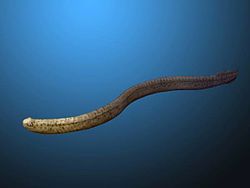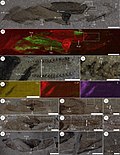Conodont
Conodonts are an extinct class of the phylum Chordata. They are now regarded as vertebrates, though the issue is still a live one.
| Conodonts | |
|---|---|
| Reconstruction of a conodont | |
| Scientific classification | |
| Kingdom: | |
| Phylum: | |
| Subphylum: | |
| Class: | Conodonta
|
| Synonyms | |
| |
For many years conodonts were known only from their feeding apparatus, which fossilises well. This is because most of the conodont animal was soft-bodied, so everything but the teeth were not fossilised in normal circumstances.
It was not until early 1980s that the conodont teeth were found with trace fossils of the host organism.[1] It came from the Lower Carboniferous lagerstätte near Edinburgh, Scotland.
Conodont elements
The 'teeth', called conodont elements, are very common in the fossil record, and have been used in biostratigraphy.
They are also used as palaeothermometers. This is because under higher temperatures the phosphate undergoes colour changes, which are measured with the conodont alteration index. This has made them useful for petroleum exploration in rocks dating from the Cambrian to the Upper Triassic.
Description of the animal
Eleven fossil imprints of conodont animals are known. They depict an eel-like creature with 15 or, more rarely, 19 elements forming a bilaterally symmetrical array in the head. This array was a feeding apparatus different from the jaws of modern animals.
There are three forms of teeth, coniform cones, ramiform bars, and pectiniform platforms, which may have performed different roles.
The organisms range from a centimeter or so to the giant Promissum, 40 cm in length.[2] It is now widely agreed that conodonts had large eyes, fins with fin rays, chevron-shaped muscles and a notochord.
The entire class of Conodonts, or at least what was left of them at the time, were wiped out by the Triassic–Jurassic extinction event, which occurred roughly 200 million years ago.[3]
Families and genera
Conodonta Pander, 1856 non Eichenberg, 1930 sensu Sweet & Donoghue, 2001 [Conodontia; Conodontophorida Eichenberg, 1930; Conodontochordata]
- Paraconodonta Müller, 1962 [Paraconodontida]
- Amphigeisiniformes
- Amphigeisinidae Miller, 1981
- Westergaardodiniformes Lindström, 1970
- Westergaardodinidae Müller, 1959 [Chosonodinidae]
- Furnishinidae Müller & Nogami, 1971
- Amphigeisiniformes
- Conodontophora Eichenberg, 1930
- Cavidonti Sweet, 1988
- Proconodontiformes Sweet, 1988
- Pseudooneotodidae Wang & Aldridge, 2010
- Proconodontidae Lindström, 1981
- Cordylodontidae Lindström, 1970 [Cyrtoniodontinae Hass, 1959]
- Fryxellodontina
- Fryxellodontidae Miller, 1981
- Pygodontidae Bergstrom, 1981
- Belodellina Sweet, 1988
- Ansellidae Faohraeus & Hunter, 1985
- Dapsilodontidae Sweet, 1988
- Belodellidae Khodalevich & Tschernich, 1973 [Cambropustulidae]
- Proconodontiformes Sweet, 1988
- Conodonti Pander, 1856 non Branson, 1938
- Oneotodontidae Miller, 1981 [Teridontidae Miller, 1981]
- Protopanderodontida Sweet, 1988 [Panderodontida]
- ?Pronodontidae Lindström, 1970
- ?Cornuodontidae Faohraeus, 1966
- ?Protopanderodontidae Lindström, 1970 [Juanognathidae Bergström, 1981]
- ?Strachanognathidae Bergström, 1981
- ?Pseudooneotodidae
- Clavohamulidae Lindström, 1970
- Drepanoistodontidae Faohraeus, 1978
- Acanthodontidae Lindström, 1970
- Scolopodontidae Bergström, 1981
- Panderodontidae Lindström, 1970
- Prioniodontida Dzik, 1976 [Distacodontida] (paraphyletic)
- ?Acodontidae Dzik, 1993 [Tripodontinae Sweet, 1988]
- ?Cahabagnathidae Stouge & Bagnoli 1999
- ?Distacodontidae Bassler, 1925 emend. Ulrich & Bassler, 1926 [Drepanodontinae Fahraeus & Nowlan, 1978; Lonchodininae Hass, 1959]
- ?Gamachignathidae Wang & Aldridge, 2010
- ?Jablonnodontidae Dzik, 2006
- ?Nurrellidae Pomešano-Cherchi, 1967
- ?Paracordylodontidae Bergström, 1981
- ?Playfordiidae Dzik, 2002
- ?Ulrichodinidae Bergström, 1981
- Rossodus Repetski & Ethington, 1983
- Multioistodontidae Harris, 1964 [Dischidognathidae]
- Oistodontidae Lindström, 1970
- Periodontidae Lindström, 1970
- Rhipidognathidae Lindström, 1970 sensu Sweet, 1988
- Prioniodontidae Bassler, 1925
- Phragmodontidae Bergström, 1981
- Plectodinidae Sweet, 1988
- Icriodontacea
- Balognathidae (Hass, 1959)
- Polyplacognathidae Bergström, 1981
- Distomodontidae Klapper, 1981
- Icriodellidae Sweet, 1988
- Icriodontidae Müller & Müller, 1957
- Prioniodinida Sweet, 1988
- ?Oepikodontidae Bergström, 1981
- ?Xaniognathidae Sweet, 1981
- Chirognathidae Branson & Mehl, 1944
- Prioniodinidae Bassler, 1925 [Hibbardellidae Mueller, 1956]
- Bactrognathidae Lindström, 1970
- Ellisoniidae Clark, 1972
- Gondolellidae Lindström, 1970
- Ozarkodinida Dzik, 1976 [Polygnathida]
- ?Anchignathodontidae Clark, 1972
- ?Archeognathidae Miller, 1969
- ?Belodontidae Huddle, 1934
- ?Coleodontidae Branson & Mehl, 1944 [Hibbardellidae Müller, 1956; Loxodontidae]
- ?Eognathodontidae Bardashev, Weddige & Ziegler, 2002
- ?Francodinidae Dzik, 2006
- ?Gladigondolellidae (Hirsch, 1994) [Sephardiellinae Plasencia, Hirsch & Márquez-Aliaga, 2007; Neogondolellinae Hirsch, 1994; Cornudininae Orchard, 2005; Epigondolellinae Orchard, 2005; Marquezellinae Plasencia et al., 2018; Paragondolellinae Orchard, 2005; Pseudofurnishiidae Ramovs, 1977]
- ?Iowagnathidae Liu et al., 2017
- ?Novispathodontidae (Orchard, 2005)
- ?Trucherognathidae Branson & Mehl, 1944
- ?Vjalovognathidae Shen, Yuan & Henderson, 2015
- ?Wapitiodontidae Orchard, 2005
- Cryptotaxidae Klapper & Philip, 1971
- Spathognathodontidae Hass, 1959 [Ozarkodinidae Dzik, 1976]
- Pterospathodontidae Cooper, 1977 [Carniodontidae]
- Kockelellidae Klapper, 1981 [Caenodontontidae]
- Polygnathidae Bassler, 1925 [?Eopolygnathidae Bardashev, Weddige & Ziegler, 2002]
- Palmatolepidae Sweet, 1988
- Hindeodontidae (Hass, 1959)
- Elictognathidae Austin & Rhodes, 1981
- Gnathodontidae Sweet, 1988
- Idiognathodontidae Harris & Hollingsworth, 1933
- Mestognathidae Austin & Rhodes, 1981
- Cavusgnathidae Austin & Rhodes, 1981
- Sweetognathidae Ritter, 1986
- Cavidonti Sweet, 1988
Conodont Media
Complete element set of the conodont Hindeodus parvus
Preserved articulated association of conodont elements belonging to the species Archeognathus primus (Ordovician, North America)
Life restoration of Promissum pulchrum
Restoration of Panderodus unicostatus
Fossils of Typhloesus, at one time considered the first conodont body fossil.
Related pages
References
- ↑ Briggs D.E.G; Clarkson E.N.K. & Aldridge R.J. 1983 (1983). "The conodont animal". Lethaia. 16: 1–14. doi:10.1111/j.1502-3931.1983.tb01993.x.
{{cite journal}}: CS1 maint: multiple names: authors list (link) - ↑ Gabbott S.E; Aldridge R.J. & Theron J.N. 1995 (1995). "A giant conodont with preserved muscle tissue from the Upper Ordovician of South Africa". Nature. 374 (6525): 800–803. doi:10.1038/374800a0. S2CID 4342260.
{{cite journal}}: CS1 maint: multiple names: authors list (link) - ↑ The extinction of conodonts – in terms of discrete elements – at the Triassic-Jurassic boundary









